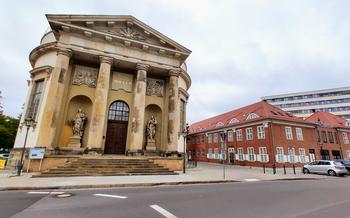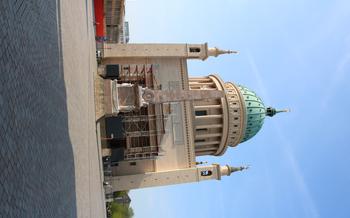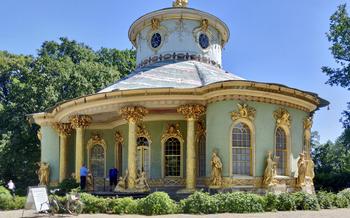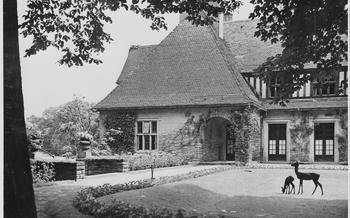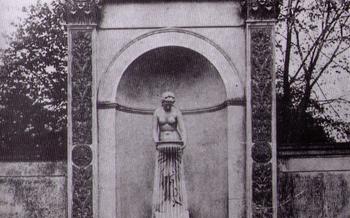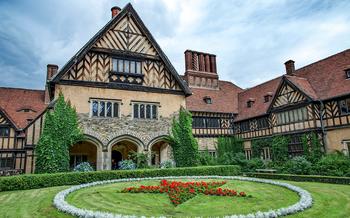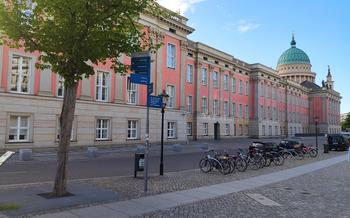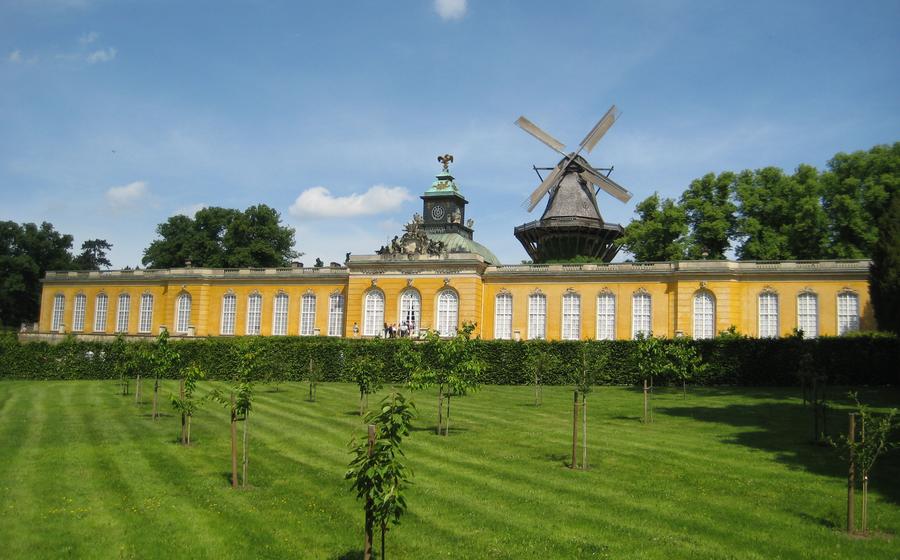
The Potsdam Museum
- The Potsdam Museum: A Journey Through History
- Historical Context
- Museum's Collection
- Educational Programs
- Accessibility for All
- Museum Shop and Cafe
- Special Events and Exhibitions
- Photography and Social Media
- Planning Your Visit
- Surrounding Attractions
- Local Cuisine and Dining
- Local Accommodation
- Insider Tip: Hidden Gem
The Potsdam Museum: A Journey Through History
The Potsdam Museum stands as a testament to the rich and diverse history of the city of Potsdam. Housed in a stunning architectural masterpiece, the museum takes visitors on a journey through time, offering a glimpse into the lives and times of Prussian kings, German emperors, and the ordinary people who shaped the city's unique character. With its extensive collection of artifacts, exhibits, and educational programs, the Potsdam Museum is a must-visit destination for anyone interested in exploring the cultural and historical heritage of this vibrant city.
Historical significance: The Potsdam Museum plays a vital role in preserving and showcasing the rich history of Potsdam. The museum's exhibits span centuries, from the city's humble beginnings as a Slavic settlement to its transformation into a flourishing royal residence and, later, a center of political power during the German Empire. Visitors can trace the city's evolution through a diverse collection of documents, artifacts, and interactive displays.
Architectural beauty: The Potsdam Museum is housed in a magnificent building that is a masterpiece of neoclassical architecture. Designed by renowned architect Karl Friedrich Schinkel, the museum's elegant facade and grand interiors create a striking backdrop for the exhibits within. The building itself is a work of art, reflecting the architectural splendor of the Prussian era.
Extensive collection: The Potsdam Museum boasts an extensive collection of over 300,000 artifacts that tell the story of Potsdam's past. From furniture and porcelain to paintings, sculptures, and historical documents, the museum's exhibits offer a comprehensive overview of the city's cultural and historical development. Visitors can explore the lives of the Hohenzollern dynasty, admire the works of renowned artists, and learn about the everyday lives of Potsdam's citizens.
Educational programs: The Potsdam Museum is committed to promoting learning and cultural engagement through a variety of educational programs. Guided tours, workshops, and lectures provide visitors with in-depth insights into the museum's exhibits and the history of Potsdam. The museum also offers educational resources for teachers and school groups, making it an ideal destination for students of all ages.
Historical Context
Potsdam, a city steeped in history, played a crucial role as the former residence of Prussian kings and German emperors. The museum, housed in a magnificent palace, was once the heart of the Hohenzollern dynasty's reign. Its grand halls and opulent chambers bear witness to the grandeur and extravagance of the Prussian monarchy.
During World War II, Potsdam suffered extensive damage, with the museum sustaining significant destruction. However, thanks to the tireless efforts of dedicated individuals and organizations, the museum was painstakingly restored to its former glory. Today, it stands as a testament to the resilience and enduring spirit of the Prussian people.
Museum's Collection
The Potsdam Museum boasts a diverse and extensive collection of artifacts and exhibits that provide a comprehensive overview of Potsdam's rich history and cultural heritage. Visitors can explore a wide range of exhibits, including paintings, sculptures, furniture, porcelain, and historical documents.
Some of the highlights of the collection include:
-
Paintings from the 17th to the 19th century: Showcasing the works of renowned artists such as Johann Christian Wentzel and Carl Blechen, these paintings offer a glimpse into Potsdam's artistic heritage.
-
Sculptures from the 18th and 19th centuries: Featuring marble and bronze sculptures by prominent artists, these works reflect the neoclassical and romantic styles popular during those periods.
-
Furniture from the 18th and 19th centuries: Visitors can admire exquisite examples of furniture from different periods, including Rococo and Biedermeier styles, which reflect the changing tastes and lifestyles of Potsdam's residents.
-
Porcelain from the Royal Porcelain Factory: Potsdam was home to the renowned Royal Porcelain Factory, and the museum houses a significant collection of porcelain from the 18th and 19th centuries, showcasing the factory's exquisite craftsmanship and artistry.
-
Historical documents and photographs: The museum also houses a collection of historical documents, photographs, and maps that provide insights into Potsdam's political, social, and economic development over the centuries.
The exhibits are organized into different themes or periods of history, allowing visitors to trace the evolution of Potsdam from its early days as a Slavic settlement to its rise as a royal residence and cultural center.
Educational Programs
The Potsdam Museum offers a range of educational programs designed to enhance the visitor experience and promote cultural engagement. Guided tours are available for groups of all sizes, led by knowledgeable guides who provide insights into the museum's history, collection, and significance. Specialized thematic tours are also offered, focusing on specific aspects of the museum's collection or historical periods.
For those seeking a deeper dive into the museum's collection, workshops and lectures are regularly organized, covering topics related to art, history, and culture. These programs are led by experts in their respective fields and provide opportunities for participants to engage with the museum's collection in a more interactive and educational manner.
The museum also caters to school groups, offering educational programs tailored to different age levels and curriculum needs. Guided tours, workshops, and interactive activities are designed to make learning about history and culture fun and engaging for students. Resources for teachers, such as lesson plans and activity sheets, are available to support classroom learning.
Accessibility for All
The Potsdam Museum is committed to providing an inclusive and accessible experience for all visitors. The museum offers a range of accessibility features to ensure that everyone can enjoy its exhibits and programs.
Wheelchair users and visitors with limited mobility can easily navigate the museum's grounds and galleries thanks to ramps, elevators, and accessible restrooms. The museum also provides wheelchairs for visitors who need them.
For visitors who are deaf or hard of hearing, the museum offers audio guides with sign language interpretation. The museum's staff is also trained to communicate with visitors using sign language.
The museum also offers a range of accessibility features for visitors with visual impairments. The museum's exhibits are well-lit, and there are large print labels and audio descriptions available for many of the exhibits. The museum also offers guided tours for visitors with visual impairments.
The Potsdam Museum is committed to providing a welcoming and inclusive environment for all visitors. The museum's accessibility features make it possible for everyone to enjoy the museum's exhibits and programs.
Museum Shop and Cafe
The Potsdam Museum boasts a well-stocked museum shop where visitors can purchase a variety of souvenirs and merchandise to commemorate their visit. From postcards and magnets to replicas of historical artifacts, the shop offers a wide selection of items for history buffs and souvenir hunters alike.
For those looking to support local artisans, the museum shop also showcases a range of locally-made products and crafts. Visitors can find unique pieces of pottery, jewelry, and textiles, all handcrafted by talented local artists. By purchasing these items, visitors not only take home a unique souvenir but also contribute to the local economy and support the preservation of traditional crafts.
After exploring the museum's exhibits, visitors can relax and recharge at the on-site cafe. The cafe offers a cozy and welcoming ambiance, with indoor and outdoor seating options. Visitors can indulge in a variety of snacks, sandwiches, and beverages, including freshly brewed coffee, tea, and cold drinks.
Whether you're looking for a unique souvenir, a locally-made gift, or a refreshing break, the Potsdam Museum's shop and cafe offer a delightful experience for visitors of all ages.
Special Events and Exhibitions
The Potsdam Museum frequently hosts special exhibitions and events that showcase unique artifacts, historical themes, or contemporary art. These exhibitions offer visitors a chance to delve deeper into specific aspects of Potsdam's history and culture. Keep an eye out for upcoming exhibitions by checking the museum's website or social media pages.
Cultural events, concerts, and performances also grace the museum's calendar, transforming it into a vibrant cultural hub. These events provide an opportunity to experience the museum from a different perspective and engage with local artists and performers.
During the holiday season, the museum hosts special events and markets, creating a festive atmosphere. Visitors can enjoy traditional German Christmas markets, complete with mulled wine, gingerbread, and handmade crafts. Seasonal activities like outdoor concerts or workshops also add to the charm of the museum during this time.
Photography and Social Media
Photography enthusiasts will be delighted to know that the Potsdam Museum encourages visitors to capture their experiences through photography. Flash photography, however, is not permitted in order to preserve the integrity of the artifacts and artwork.
The museum is also active on social media platforms, allowing visitors to connect and share their experiences with the world. Follow the museum on Twitter, Instagram, and Facebook to stay updated on upcoming exhibitions, events, and behind-the-scenes glimpses. Share your own photos and videos using the hashtag #PotsdamMuseum to join a vibrant community of art and history enthusiasts.
Planning Your Visit
To ensure a smooth and enjoyable experience, planning your visit to the Potsdam Museum is essential. Here are a few tips to help you make the most of your time:
Advance Booking: During the peak tourist season (spring and summer), it's advisable to book your tickets online in advance. This will guarantee your entry and avoid long queues at the ticket counter.
Allow Sufficient Time: The Potsdam Museum is vast and houses numerous exhibits. To fully appreciate the collection and explore the grounds, plan to dedicate at least two to three hours for your visit.
Combination Tickets: The museum offers combination tickets that include admission to other nearby attractions, such as the Sanssouci Palace and the New Palace. These tickets provide a cost-effective way to explore multiple sites in Potsdam.
Surrounding Attractions
A visit to the Potsdam Museum can be effortlessly combined with an exploration of the city's other captivating landmarks. Just a short stroll away, visitors can marvel at the majestic Sanssouci Palace, a UNESCO World Heritage Site and a testament to Prussian architectural prowess. Take a leisurely stroll through the meticulously manicured gardens that surround the palace, admiring the vibrant flowerbeds, sculptures, and fountains that grace its grounds.
Potsdam's rich history is further unveiled at the nearby Cecilienhof Palace, where the Potsdam Conference, a pivotal event in the aftermath of World War II, took place. Explore the grand halls and chambers where the fate of postwar Europe was decided, gaining insights into this significant historical juncture.
For a glimpse into Potsdam's industrial heritage, head to the Schiffbauergasse, a former shipyard that has been transformed into a vibrant cultural hub. Here, visitors can peruse art galleries, boutiques, and charming cafes, soak in the creative atmosphere, and appreciate the unique blend of old and new that defines this revitalized district.
Local Cuisine and Dining
Indulge in the culinary delights of Potsdam and savor the flavors of local dishes and specialties. Explore the charming cafes and restaurants nestled in the vicinity of the museum, offering a diverse range of culinary experiences. From traditional German fare to international cuisine, there's something to satisfy every palate.
For a truly authentic experience, try local specialties such as Maultaschen, a type of stuffed pasta, or Schupfnudeln, potato dumplings often served with sauerkraut. Don't miss the chance to sample local beers, including the famous Potsdamer Stange, a refreshing pilsner-style beer.
If you prefer a more casual dining experience, consider packing a picnic lunch and enjoying it in the picturesque surroundings of the museum grounds or nearby parks. Find a cozy spot beneath the shade of a tree and relish the tranquility of your surroundings as you savor your meal.
Local Accommodation
When planning your visit to Potsdam, a range of accommodation options are available to suit different preferences and budgets. For those seeking a luxurious and convenient stay, the Hotel am Luisenplatz, located just a short walk from The Potsdam Museum, offers elegant rooms and suites with stunning views of the city. Alternatively, the Mercure Hotel Potsdam City, situated in the heart of the city center, provides comfortable and modern accommodations with easy access to local attractions.
For budget-conscious travelers, the Jugendherberge Potsdam, a modern hostel located near the river Havel, offers affordable dormitory-style rooms and private rooms. Another option is the Pension Am Havelufer, a charming guesthouse situated in a historic building, which provides cozy rooms with a homely atmosphere.
For those seeking a unique and immersive experience, consider staying at the Historisches Hotel Alte Posthalterei, a former coaching inn that has been lovingly restored and transformed into a charming hotel. With its traditional German architecture and warm hospitality, this hotel offers a glimpse into Potsdam's rich history.
If you plan to stay in Potsdam for an extended period, consider renting an apartment or a vacation home. Several websites and local agencies offer a variety of options, from cozy studios to spacious family-friendly accommodations. This option provides more flexibility and allows you to experience Potsdam like a local.
Insider Tip: Hidden Gem
Beyond the main exhibits, the Potsdam Museum holds a hidden gem that often goes unnoticed by visitors. In the basement of the museum, tucked away from the hustle and bustle of the main galleries, lies a secret room filled with forgotten treasures. This room, known as the "Depot," houses a vast collection of artifacts that have been deemed too fragile or obscure for display in the main exhibits. Here, visitors can discover a fascinating array of objects, from ancient pottery shards to medieval manuscripts, that tell the story of Potsdam's rich history. While the Depot is not always open to the public, visitors who inquire at the museum's information desk may be granted special access to this hidden treasure trove.



